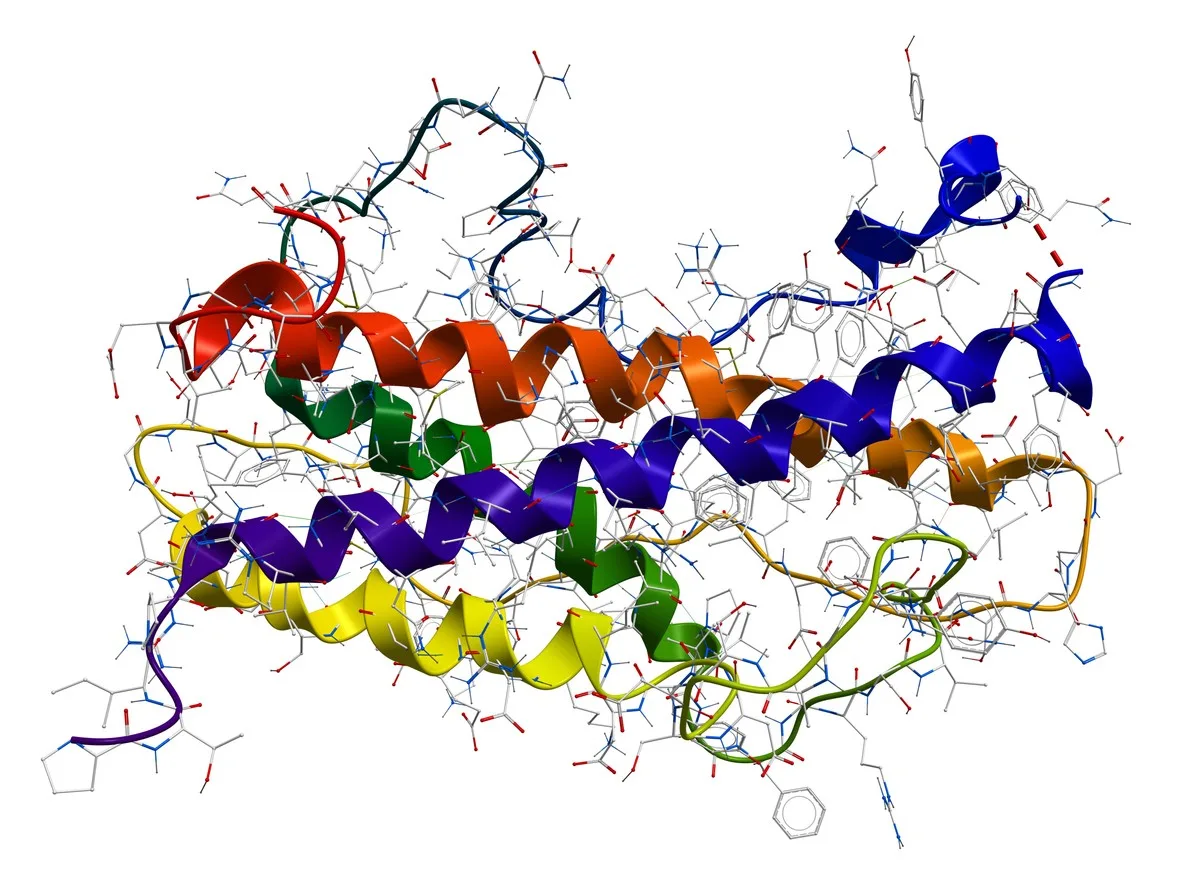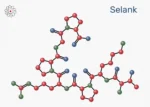Research into Tesamorelin has principally centered on its possible utility within the context of metabolic disorders, particularly in the context of HIV-associated lipodystrophy.[1] On the other hand, Ipamorelin appears to have exhibited promise in a wider range of research fields, including obesity and growth promotion.[2]
This introductory exposition explores the scientific foundation underlying Tesamorelin and Ipamorelin, and underscores their potential synergy, highlighting the importance of further exploratory research in elucidating their combined pharmacological actions.
Tesamorelin
Tesamorelin is a synthetic peptide with a specific amino acid sequence, also known as a growth hormone-releasing peptide (GHRP). Its structure consists of a chain of 44 amino acids, and it appears to function by stimulating the release of growth hormone (GH) from the pituitary gland.[3]
Tesamorelin has been studied for its potential action in research concerning conditions like HIV-associated lipodystrophy and age-related decline in GH levels. Its speculated ability to enhance GH secretion makes it an intriguing subject of research within the context of various health-related issues, although further studies are needed to fully determine its potential.
Ipamorelin
Ipamorelin is a synthetic peptide belonging to the family of growth hormone-releasing peptides (GHRPs). Its chemical structure consists of five amino acids: alanine, glutamine, histidine, leucine, and arginine.[4]
Scientists suggest that this specific sequence appears to impart Ipamorelin with the ability to stimulate the release of growth hormone (GH) by activating the ghrelin receptor, a property that potentially makes it a potent GH secretagogue. Unlike some other GHRPs, Ipamorelin appears to exhibit selective action with minimal impact on other hormones, making it an attractive candidate for research related to GH regulation.
Mechanism of Action
Tesamorelin
Tesamorelin appears to exert physiological action through the activation of growth hormone releasing hormone (GHRH) receptors localized within the anterior pituitary gland. This activation, in turn, is said to elicit an augmented synthesis and release of growth hormone (GH) into the bloodstream. Subsequently, GH appears to exert its multifaceted actions on various cell types, including hepatocytes, thereby prompting the synthesis of insulin-like growth factor-1 (IGF-1). IGF-1, akin to GH, is considered to play a pivotal role in cellular growth promotion, apoptosis inhibition, glucose regulation, and lipolysis.[5]
Notably, study findings have indicated that research models of HIV-associated lipodystrophy often manifest diminished levels of GH and IGF-1. Tesamorelin may rectify this imbalance, possibly managing overall lipid metabolism and accumulation.
An intriguing aspect of Tesamorelin lies in its structural modification at the N-terminus, diverging from natural GHRH. This structural alteration appears to enhance peptide stability and may confer heightened resistance to enzymatic deactivation.
Ipamorelin
Ipamorelin represents a pioneering synthetic growth hormone secretagogue that appears to operate by enhancing the endogenous production of growth hormone. It is speculated to elicit the release of growth hormone from the anterior pituitary gland, thereby sustaining physiological hormone levels.
This peptide appears to exhibit a remarkable degree of specificity for the growth hormone-releasing peptide (GHRP) receptors situated within the pituitary gland. Analogous to other GHRP receptor agonists, Ipamorelin may engage these receptors to stimulate the secretion of growth hormone, hGH.[6]
Research and Scientific Studies
Tesamorelin and Ipamorelin Peptide Blend and Growth Hormone Deficiency
The Tesamorelin and Ipamorelin blend appears to exhibit a multifaceted mechanism of action that, when combined, may offer synergistic effects in the context of growth hormone deficiency.
When introduced concurrently, the Tesamorelin and Ipamorelin blend has been suggested by researchers to manifest a dual-action approach. Tesamorelin appears to stimulate GH release via GHRH receptor activation, while Ipamorelin seems to directly stimulate GHSR, apparently leading to increased GH secretion. This combined action is presumed to amplify the overall GH response, potentially offering advantages in terms of optimizing mass composition, lipid profiles, insulin sensitivity, and overall metabolic functionality.
By addressing different components of the growth hormone axis through their distinct mechanisms, Tesamorelin and Ipamorelin may possibly enhance, collectively, pituitary gland activity that ultimately facilitates the release of endogenous growth hormone.[7]
Tesamorelin and Ipamorelin Peptide Blend and Lipodystrophy
Lipodystrophy often accompanies insulin resistance, dyslipidemia, and an elevated susceptibility to cardiovascular complications. Clinical research has indicated that the introduction of Tesamorelin to lipodystrophic research subjects may engender a noteworthy reduction in visceral adipose tissue (VAT) alongside possible enhancements in insulin sensitivity and lipid profiles.
Tesamorelin’s mechanism of action appears to involve the activation of the growth hormone-releasing hormone receptor (GHRHR), potentially fostering the secretion of endogenous growth hormone and facilitating lipolysis. As a result, Tesamorelin may contribute to the preservation of abdominal subcutaneous adipose tissue and favorable alterations in lipid metabolism.
In parallel, Ipamorelin has exhibited signs of promise in modulating adipose tissue metabolism. The conjecture surrounding the combined utilization of Tesamorelin and Ipamorelin postulates synergistic effects, which may further augment the reduction of VAT and ameliorate metabolic parameters in models of lipodystrophy.[8]
Tesamorelin and Ipamorelin Peptide Blend and Cognitive Improvement
Growing study data suggests that growth hormone and its secretagogues, including Tesamorelin and Ipamorelin, may exert modulatory influences on neuroplasticity, neuronal survival, and synaptic plasticity, all pivotal elements for optimal cognitive function. Preclinical investigations have revealed that Tesamorelin may potentially enhance memory and learning capacities, possibly via neurogenesis and synaptic plasticity.
Concurrently, Ipamorelin appears to have some potential to augment spatial memory and cognitive function in animal models. The combined presentation of Tesamorelin and Ipamorelin may prospectively magnify these cognitive benefits through their proposed synergistic mechanisms of action. However, the validation of these findings and the elucidation of the blend’s biological effects on cognitive functioning necessitate future study.
Tesamorelin and Ipamorelin Peptide Blend and Type 2 Diabetes
The combination of Tesamorelin and Ipamorelin has garnered attention of researchers within the context of Type 2 Diabetes Mellitus (T2DM) due to promising outcomes observed in exploratory investigations. Both peptides appear to exhibit potential for enhancing glycemic control and ameliorating the metabolic irregularities associated with T2DM.
Tesamorelin’s mechanism of action is speculated to involve the stimulation of endogenous growth hormone secretion, a process linked to improved insulin sensitivity and enhanced glucose utilization. Ipamorelin similarly has been suggested to influence glucose metabolism and insulin sensitivity. When presented together, Tesamorelin and Ipamorelin may confer complementary impacts, potentially encompassing reductions in hemoglobin A1c (HbA1c) levels, enhancements in insulin sensitivity, and reductions in visceral adiposity in the case of T2DM.[9]
Tesamorelin and Ipamorelin Peptide Blend and Pituitary Glad
The combination of Tesamorelin and Ipamorelin may have a notable influence on the pituitary gland, a pivotal endocrine organ responsible for the regulation of growth hormone secretion.
Research indicates that Tesamorelin may possess a specific affinity for the growth hormone-releasing hormone receptor (GHRHR), potentially initiating the intracellular signaling cascade leading to the synthesis and subsequent release of growth hormone. As supported by previous studies, “Tesamorelin, as a synthetic growth hormone-releasing hormone, exerts its action on the anterior pituitary gland to stimulate endogenous growth hormone secretion”[10]
In contrast, Ipamorelin exhibits potent agonistic activity toward the growth hormone secretagogue receptor (GHSR), possibly facilitating the secretion of growth hormone. As documented in scientific literature, “Ipamorelin stands as the pioneering GHRP-receptor agonist, demonstrating a selectivity for GH release akin to that of GHRH. The specificity inherent in Ipamorelin positions it as a compelling candidate for prospective clinical development”[11]
When introduced together, these peptides appear to elicit a synergistic effect on the pituitary gland, potentially resulting in heightened production of growth hormone. This cooperative interplay between Tesamorelin and Ipamorelin holds promise as a valuable avenue for the optimization of growth hormone levels.[7]
In Summary
The combination of Tesamorelin and Ipamorelin peptides, when introduced concurrently, presents an intriguing prospect for magnifying biological benefits through their proposed complementary modes of action. By jointly stimulating the growth hormone axis and modulating neurotrophic factors, this peptide blend may hold promise as a catalyst for cognitive improvement.
The majority of these findings stem from research conducted in animal models. Therefore, ongoing research remains imperative to fully harness the benefits of these peptides and explore their relevance in the realm of cognitive improvement across a wider variety of species.
Disclaimer: The products mentioned are not intended for human or animal consumption. Research chemicals are intended solely for laboratory experimentation and/or in-vitro testing. Bodily introduction of any sort is strictly prohibited by law. All purchases are limited to licensed researchers and/or qualified professionals. All information shared in this article is for educational purposes only.
References:
- Dhillon S. Tesamorelin: a review of its use in the management of HIV-associated lipodystrophy. Drugs. 2011 May 28;71(8):1071-91. doi: 10.2165/11202240-000000000-00000. PMID: 21668043. https://pubmed.ncbi.nlm.nih.gov/21668043/
- Gao Y, Yuan X, Zhu Z, Wang D, Liu Q, Gu W. Research and prospect of peptides for use in obesity treatment (Review). Exp Ther Med. 2020 Dec;20(6):234. doi: 10.3892/etm.2020.9364. Epub 2020 Oct 16. PMID: 33149788; PMCID: PMC7604735. https://www.ncbi.nlm.nih.gov/pmc/articles/PMC7604735/
- National Center for Biotechnology Information (2023). PubChem Compound Summary for , Tesamorelin. https://pubchem.ncbi.nlm.nih.gov/compound/Tesamorelin.
- National Center for Biotechnology Information (2023). PubChem Compound Summary for CID 9831659, Ipamorelin. https://pubchem.ncbi.nlm.nih.gov/compound/Ipamorelin.
- LiverTox: Clinical and Research Information on Drug-Induced Liver Injury [Internet]. Bethesda (MD): National Institute of Diabetes and Digestive and Kidney Diseases; 2012-. Tesamorelin. [Updated 2018 Oct 20]. Available from: https://www.ncbi.nlm.nih.gov/books/NBK548730/
- K. Raun et al., Ipamorelin, the first selective growth hormone secretagogue, European Journal of Endocrinology, November 1998, 139 552-561. https://pubmed.ncbi.nlm.nih.gov/9849822/
- Rogério G. Gondo et al, Growth Hormone-Releasing Peptide-2 Stimulates GH Secretion in GH-Deficient Patients with Mutated GH-Releasing Hormone Receptor, The Journal of Clinical Endocrinology & Metabolism, Volume 86, Issue 7, 1 July 2001, Pages 3279–3283, https://doi.org/10.1210/jcem.86.7.7694
- Falutz J, Mamputu JC, Potvin D, Moyle G, Soulban G, Loughrey H, Marsolais C, Turner R, Grinspoon S. Effects of tesamorelin (TH9507), a growth hormone-releasing factor analog, in human immunodeficiency virus-infected patients with excess abdominal fat: a pooled analysis of two multicenter, double-blind placebo-controlled phase 3 trials with safety extension data. J Clin Endocrinol Metab. 2010 Sep;95(9):4291-304. doi: 10.1210/jc.2010-0490. Epub 2010 Jun 16. PMID: 20554713. https://pubmed.ncbi.nlm.nih.gov/20554713
- Clemmons DR, Miller S, Mamputu JC. Safety and metabolic effects of tesamorelin, a growth hormone-releasing factor analogue, in patients with type 2 diabetes: A randomized, placebo-controlled trial. PLoS One. 2017 Jun 15;12(6):e0179538. doi: 10.1371/journal.pone.0179538. PMID: 28617838; PMCID: PMC5472315. https://www.ncbi.nlm.nih.gov/pmc/articles/PMC5472315/
- Adrian S, Scherzinger A, Sanyal A, Lake JE, Falutz J, Dubé MP, Stanley T, Grinspoon S, Mamputu JC, Marsolais C, Brown TT, Erlandson KM. The Growth Hormone Releasing Hormone Analogue, Tesamorelin, Decreases Muscle Fat and Increases Muscle Area in Adults with HIV. J Frailty Aging. 2019;8(3):154-159. doi: 10.14283/jfa.2018.45. PMID: 31237318; PMCID: PMC6766405. https://www.ncbi.nlm.nih.gov/pmc/articles/PMC6766405/
- Raun K, Hansen BS, Johansen NL, Thøgersen H, Madsen K, Ankersen M, Andersen PH. Ipamorelin, the first selective growth hormone secretagogue. Eur J Endocrinol. 1998 Nov;139(5):552-61. doi: 10.1530/eje.0.1390552. PMID: 9849822. https://pubmed.ncbi.nlm.nih.gov/9849822/







